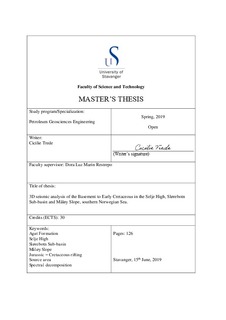| dc.contributor.advisor | Restrepo, Dora Luz Marin | |
| dc.contributor.author | Trede, Cicilie | |
| dc.date.accessioned | 2019-10-01T13:22:52Z | |
| dc.date.available | 2019-10-01T13:22:52Z | |
| dc.date.issued | 2019-06-15 | |
| dc.identifier.uri | http://hdl.handle.net/11250/2619661 | |
| dc.description | Master's thesis in Petroleum Geosciences Engineering | nb_NO |
| dc.description.abstract | Several coarse-grained sedimentary rocks have been reported in the Upper Jurassic and the Cretaceous succession in the southern Norwegian Sea and the northern North Sea. The Jurassic interval has been interpreted as syn-rift deposits while the Cretaceous succession is considered post-rift strata. However, the timing of the fault activity in the Early Cretaceous has been debated. In addition, the coarse-grained sandstones of the Early Cretaceous Agat Formation are still poorly understood, and few studies are related to this interval in the Selje High area. Furthermore, the basement in the northern North Sea in the Utsira High has proven to bear potential as a reservoir in fractured basement rocks, nevertheless, further studies are needed on this in the northern North Sea. This study aims to improve the understanding of the fault activity in the Late Jurassic to Early Cretaceous and the lateral distribution of the coarse-grained formations of Early Cretaceous, thus improve the paleogeographic understanding in the area surrounding Selje High. A further purpose is to improve the understanding of the Pre-Devonian basement.
This is accomplished by using a dataset containing 3D and 2D reflection seismic and six wells. In addition to traditional seismic interpretation, spectral decomposition was used to highlight the Basement and the Agat Formation.
Main findings comprise of three fault families of Late Jurassic age exposed to rotation which uplifted basement highs. These were later reactivated during the late Early Cretaceous. However, a second theory is suggested favoring thermal subsidence in the Early Cretaceous. The main controlling factor on the lateral extent of the coarse-grained Agat Formation is the rifting bathymetry from the Late Jurassic and eustatic sea level changes. The Agat Formation is sourced as slumps from the Selje High and submarine fans from the eastern platform area through submarine canyons of Late Jurassic age. These submarine canyons are found in the basement of structural highs and are present up until the Base Cretaceous Unconformity. Lastly, the basement proved to have minor faulting or fractures in the Selje High, thus possibly bearing the potential as a reservoir. | nb_NO |
| dc.language.iso | eng | nb_NO |
| dc.publisher | University of Stavanger, Norway | nb_NO |
| dc.relation.ispartofseries | Masteroppgave/UIS-TN-IER/2019; | |
| dc.rights | Navngivelse 4.0 Internasjonal | * |
| dc.rights.uri | http://creativecommons.org/licenses/by/4.0/deed.no | * |
| dc.subject | petroleumsgeologi | nb_NO |
| dc.subject | Agat Formation | nb_NO |
| dc.subject | Selje High | nb_NO |
| dc.subject | Slørebotn Sub-basin | nb_NO |
| dc.subject | Måløy Slope | nb_NO |
| dc.subject | Jurassic - Cretaceous rifting | nb_NO |
| dc.subject | source area | nb_NO |
| dc.subject | spectral decomposition | nb_NO |
| dc.subject | petroleum geology | nb_NO |
| dc.title | 3D seismic analysis of the Basement to Early Cretaceous in the Selje High, Slørebotn Sub-basin and Måløy Slope, southern Norwegian Sea. | nb_NO |
| dc.type | Master thesis | nb_NO |
| dc.subject.nsi | VDP::Technology: 500::Rock and petroleum disciplines: 510::Geological engineering: 513 | nb_NO |
| dc.subject.nsi | VDP::Mathematics and natural science: 400::Geosciences: 450::Petroleum geology and petroleum geophysics: 464 | nb_NO |

